Namibia trip report (Part 4 - Lüderitz and the Sperrgebiet)
 Tuesday, July 14, 2009 at 03:43PM
Tuesday, July 14, 2009 at 03:43PM
This is the 4th trip report from my latest safari to Namibia You can read my Namibia trip report (Part 1 - Skeleton Coast) entry, Namibia trip report (Part 2 - Serra Cafema) entry and finally my Namibia trip report (Part 3 - Namib-Naukluft) if you have not already done so.
After Sossusvlei and the Namib-Naukluft Park, the first safari group and I flew back to the capital city of Windhoek. I said goodbye to everybody and headed back to the Olive Grove for some relaxation, laundry service and emails. After a few hours I saw some of my next safari group, and I went back to work and went back into 'host' mode.
The next morning we headed to the airport to board our private charter to Lüderitz, along the southwestern coast. Lüderitz is an unusual place, as it still has the colonial German feeling to it, and it is quite isolated. It is bound by the coast to the west, the impenetrable sand dunes to the north, and the Sperrgebiet diamond mining around to the south. There is only 1 major road in and out. The primary reason to travel there was for us to photograph the abandoned mining town of Kolmanskop. Kolmanskop (established in 1908) was not a huge town, but it was definitely a modern town in its heyday. It had electricity, a gymnasium, bowling alley and many other creature comforts of home.
On this trip I had a clearance issue for a 'working photographer' in the controlled diamond mining area, so the images below were pulled from some of my prior trips. There was some confusion as to who had applied for the work permit to operate there, so rather I put my camera down and helped my workshop participants instead of shooting.
The challenge with photographing at Kolmanskop is the extreme dynamic range. This is a great place to practice your HDR skills, however I have never liked any HDR output from my own efforts. For some reason I just don't like the look, and I would rather clip a highlight or have deep blacks, as it looks more realistic to my eyes. The abandoned buildings are an excellent study in reflected light, and there are extremely bold colors inside many of the homes. Most of my exposures from my visits to Kolmanskop are between 1 and 5 seconds with a 16-35mm lens. The Sony 16-35mm f/2.8 lens is head and shoulders better than the Canon 16-35mm series I or II, and almost as good as the Nikon 14-24mm, even though they aren't the same focal range. The Sony 16-35mm is also as good as my Nikon 17-35mm, which I use for most of my wild angle needs. For anybody traveling to Namibia, Kolmanskop is the only location where I have gotten away with a smaller tripod. All other locations are subject to winds, and a smaller tripod just doesn't work everywhere else. On this trip I brought my Gitzo 3540. My first trip to Namibia back in 2006 I brought a Gitzo 1258, and I quickly switched to a larger model after that.
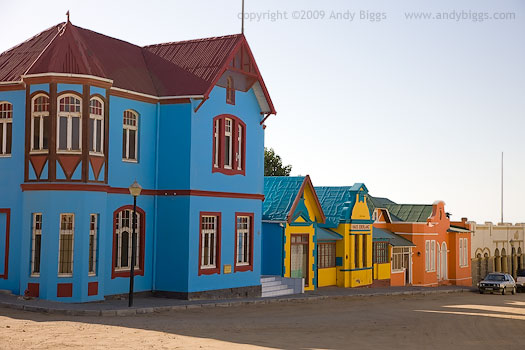
Colorful streets of Lüderitz! It certainly doesn't have a feel of Africa when you are walking the streets. Many or most of the street names are still in German, not Afrikaans, English or any other local language.
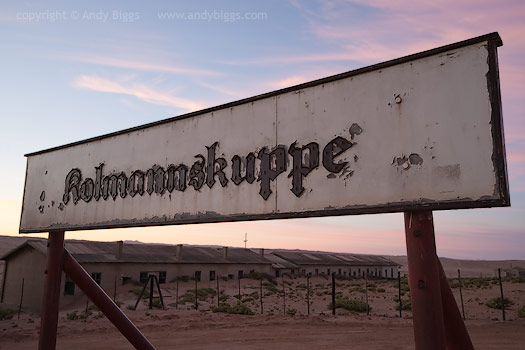 Relic of the past
Relic of the past
 This image took some playing with to get what I wanted. There was so little light inside, and we threw sand up in the air to get the lines of light to be sharp and visible.
This image took some playing with to get what I wanted. There was so little light inside, and we threw sand up in the air to get the lines of light to be sharp and visible.
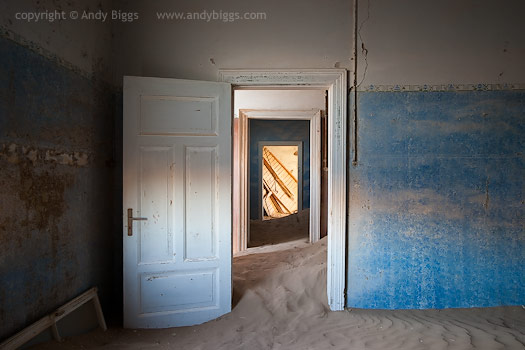
The tunnel effect? I was trying to capture soft, dappled light that was reflected all around the room.
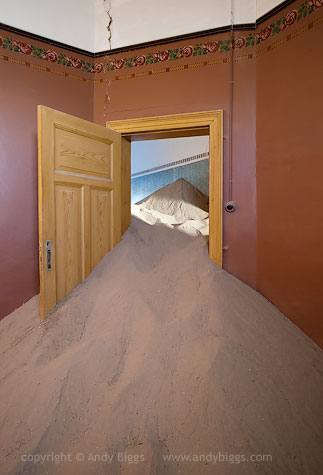
I love this particular house, and I have photographed it many times now. I have tried both vertical and horizontal compositions in the rooms, and I never can get to a point where I am happy with either. This time I had the early morning light crossing over the sand in the background, which was a nice touch. Notice the intricate, hand-painted stenciling near the top of the room. Just amazing how nice their homes must have been in the middle of nowhere.
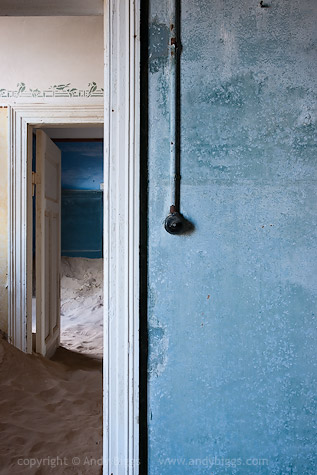
Power switch. Ah, nothing like power in the desert.
 Kolmanslop,
Kolmanslop,  Luderitz,
Luderitz,  namibia in
namibia in  News,
News,  Safaris
Safaris 



Reader Comments (1)
Great pictures!